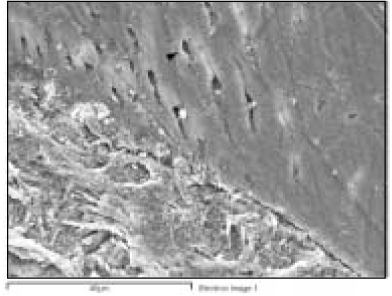J Korean Acad Conserv Dent.
2004 Jan;29(1):51-57. 10.5395/JKACD.2004.29.1.051.
Sealing ability of root canals obturated with gutta-percha, epoxy resin-based sealer, and dentin adhesives
- Affiliations
-
- 1Department of Conservative Dentistry, School of Dentistry, Seoul National University, Korea. baeks@plaza.snu.ac.kr
- KMID: 1987084
- DOI: http://doi.org/10.5395/JKACD.2004.29.1.051
Abstract
- No abstract available.
Figure
Cited by 1 articles
-
Prognostic factors influencing clinical outcome of nonsurgical endodontic treatment
Seonah Kim
J Korean Acad Conserv Dent. 2010;35(6):436-444. doi: 10.5395/JKACD.2010.35.6.436.
Reference
-
1. Zidan O, ElDeeb ME. The use of dentinal bonding agent as root canal sealer. J Endod. 1985. 11:176–178.2. Torabinejad M, Handysiders R, Khademi A, Bakland LK. Clinical implications of the smear layer in endodontics. Oral Surg Oral Med Oral Pathol Oral Radiol Endod. 2002. 94:658–666.3. Economides N, Liolios E, Kolokuris I, Beltes P. Long-term evaluation of influence of smear layer removal on the sealing ability. J Endod. 1999. 25:123–125.
Article4. Gettleman BH, Messer HH, ElDeeb ME. Adhesion of sealer cements to dentin with and without the smear layer. J Endod. 1991. 17:15–20.
Article5. De Gee AJ, Wu MK, Wesselink PR. Sealing properties of Ketac-Endo glass ionomer cement and AH26 root canal sealers. Int Endod J. 1994. 27:239–244.
Article6. Nakabayashi N, Takarada K. Effect of HEMA on bonding to dentin. Dent Mater. 1992. 8:125–130.
Article7. Mannocci F, Ferrari M. Apical seal of roots obturated with laterally condensed gutta-percha, epoxy resin cement, and dentin bonding agent. J Endod. 1998. 24:41–44.
Article8. Leonard JE, Gutmann JL, Guo IY. Apical and coronal seal of roots obturated with a dentine bonding agent and resin. Int Endod J. 1996. 29:76–83.
Article9. Bae KS, Nakata TT, Baumgartner JC. Development of an anaerobic bacterial leakage model. J Endod. 1998. 24:233–235.
Article10. Torabinejad M, Ung B, Kettering JD. In vitro bacterial penetration of coronally unsealed endodontically treated teeth. J Endod. 1990. 16:566–569.
Article11. Saunders EM, Saunders WP. Long-term coronal leakage of JS Quickfill root fillings with Sealapex and Apexit sealers. Endod Dent Traumatol. 1995. 11:181–185.
Article12. Kennedy WA, Walker WA 3rd, Gough RW. Smear layer removal effects on apical leakage. J Endod. 1986. 12:21–27.
Article13. Imai Y, Komabayashi T. Properties of a new injectable type of root canal filling resin with adhesiveness to dentin. J Endod. 2003. 29:20–23.
Article14. Erickson RL. Surface interaction of dentine adhesive materials. Oper Dent. 1992. Suppl 5. 81–94.15. Assouline LS, Mazor Y, Weiss EI. Bacterial penetration and proliferation in root canal dentinal tubules after applying dentin adhesives in vitro. J Endod. 2001. 27:398–400.
Article16. Krakow AA, Destoppelaar JD, Gron P. In vivo study of temporary filling materials in endodontics in anterior teeth. Oral Surg Oral Med Oral Pathol. 1997. 43:615–620.
Article
- Full Text Links
- Actions
-
Cited
- CITED
-
- Close
- Share
- Similar articles
-
- Bacterial leakage and micro-computed tomography evaluation in round-shaped canals obturated with bioceramic cone and sealer using matched single cone technique
- The effect of canal filling with gutta-percha or resilon on Enterococcus faecalis in bovine dentinal tubules
- Comparison of warm gutta-percha condensation techniques in ribbon shaped canal: weight of filled gutta-percha
- Effect of irrigation methods on the adhesion of Resilon/Epiphany sealer and gutta-percha/AH 26 sealer to intracanal dentin
- Effect of soft chelating irrigation on the sealing ability of GP/AH Plus root fillings





